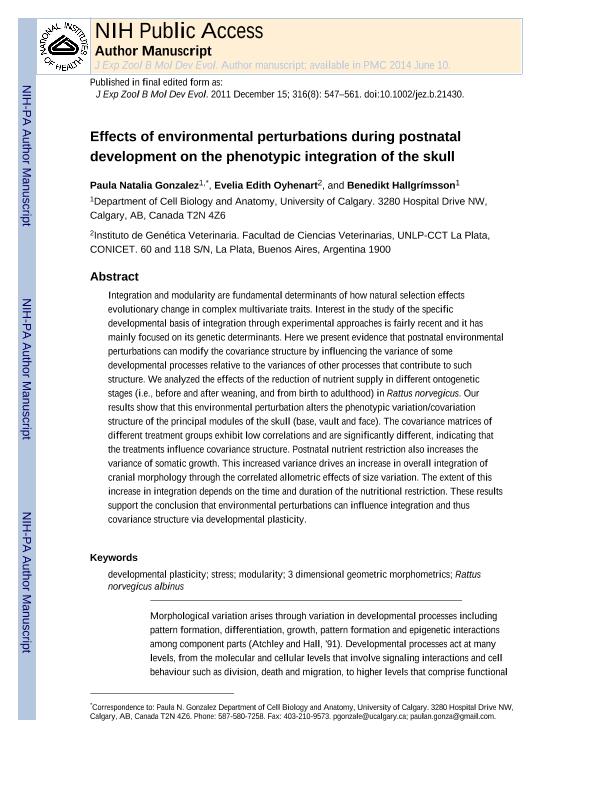Mostrar el registro sencillo del ítem
dc.contributor.author
Gonzalez, Paula Natalia

dc.contributor.author
Oyhenart, Evelia Edith

dc.contributor.author
Hallgrimsson, Benedikt

dc.date.available
2019-06-27T01:13:47Z
dc.date.issued
2011-12
dc.identifier.citation
Gonzalez, Paula Natalia; Oyhenart, Evelia Edith; Hallgrimsson, Benedikt; Effects of environmental perturbations during postnatal development on the phenotypic integration of the skull; Veterinary and Human Toxicology; Journal Of Experimental Zoology Part B-molecular And Developmental Evolution; 316 B; 8; 12-2011; 547-561
dc.identifier.issn
1552-5007
dc.identifier.uri
http://hdl.handle.net/11336/78887
dc.description.abstract
Integration and modularity are fundamental determinants of how natural selection effects evolutionary change in complex multivariate traits. Interest in the study of the specific developmental basis of integration through experimental approaches is fairly recent and it has mainly focused on its genetic determinants. In this study, we present evidence that postnatal environmental perturbations can modify the covariance structure by influencing the variance of some developmental processes relative to the variances of other processes that contribute to such structure. We analyzed the effects of the reduction of nutrient supply in different ontogenetic stages (i.e. before and after weaning, and from birth to adulthood) in Rattus norvegicus. Our results show that this environmental perturbation alters the phenotypic variation/covariation structure of the principal modules of the skull (base, vault, and face). The covariance matrices of different treatment groups exhibit low correlations and are significantly different, indicating that the treatments influence covariance structure. Postnatal nutrient restriction also increases the variance of somatic growth. This increased variance drives an increase in overall integration of cranial morphology through the correlated allometric effects of size variation. The extent of this increase in integration depends on the time and duration of the nutritional restriction. These results support the conclusion that environmental perturbations can influence integration and thus covariance structure via developmental plasticity.
dc.format
application/pdf
dc.language.iso
eng
dc.publisher
Veterinary and Human Toxicology

dc.rights
info:eu-repo/semantics/openAccess
dc.rights.uri
https://creativecommons.org/licenses/by-nc-nd/2.5/ar/
dc.subject
Environmental Perturbations
dc.subject
Phenotypic Integration
dc.subject
Iugr
dc.subject.classification
Salud Pública y Medioambiental

dc.subject.classification
Ciencias de la Salud

dc.subject.classification
CIENCIAS MÉDICAS Y DE LA SALUD

dc.title
Effects of environmental perturbations during postnatal development on the phenotypic integration of the skull
dc.type
info:eu-repo/semantics/article
dc.type
info:ar-repo/semantics/artículo
dc.type
info:eu-repo/semantics/publishedVersion
dc.date.updated
2019-06-11T21:16:39Z
dc.journal.volume
316 B
dc.journal.number
8
dc.journal.pagination
547-561
dc.journal.pais
Estados Unidos

dc.journal.ciudad
Nueva York
dc.description.fil
Fil: Gonzalez, Paula Natalia. University of Calgary; Canadá
dc.description.fil
Fil: Oyhenart, Evelia Edith. Consejo Nacional de Investigaciones Científicas y Técnicas. Centro Científico Tecnológico CONICET- La Plata. Instituto de Genética Veterinaria "Ing. Fernando Noel Dulout". Universidad Nacional de La Plata. Facultad de Ciencias Veterinarias. Instituto de Genética Veterinaria; Argentina
dc.description.fil
Fil: Hallgrimsson, Benedikt. University of Calgary; Canadá
dc.journal.title
Journal Of Experimental Zoology Part B-molecular And Developmental Evolution

dc.relation.alternativeid
info:eu-repo/semantics/altIdentifier/url/https://www.ncbi.nlm.nih.gov/pmc/articles/PMC4050671/
dc.relation.alternativeid
info:eu-repo/semantics/altIdentifier/url/https://onlinelibrary.wiley.com/doi/10.1002/jez.b.21430
dc.relation.alternativeid
info:eu-repo/semantics/altIdentifier/doi/https://doi.org/10.1002/jez.b.21430
Archivos asociados
